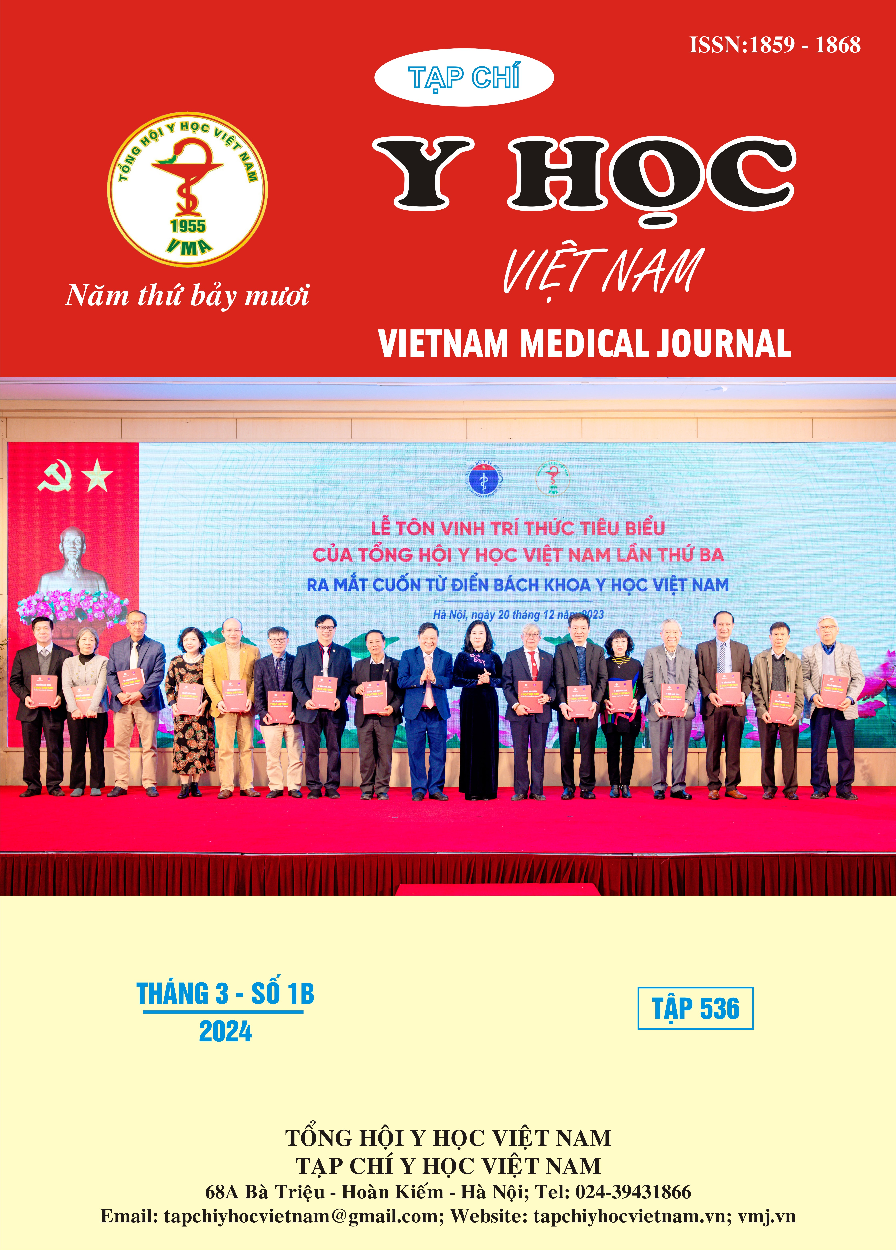EVALUATION OF INITIAL RESULTS OF INDUCTION CHEMICAL HEAD AND NECK CANCER TREATMENT STAGES III – IVA AT MILITARY HOSPITAL 103
Main Article Content
Abstract
Objectives: To evaluate the initial results of induction chemotherapy for head and neck cancer stage III - IVA at Military Hospital 103. Subjects and methods: a retrospective descriptive combined with prospective study on 29 stage III-IVA head and neck cancer patients. All of patients was received induction chemotherapy at the Oncology Center of Military Hospital 103 from January 2021 to August 2023. Results: After 3 cycles of induction chemotherapy 77.27% reduces symptoms of cervical lymph nodes, 66.67% reduces choking, 71.43% reduces hoarseness, 75% reduces headaches; 66.67% completely eliminated tinnitus and nosebleeds. According to RECIST 1.1, complete response is 17.25%, partial response is 58.62%; stable disease is 20.68%; advance disease is 3.45%. In the group of hypopharyngeal and laryngeal cancer 18.75% had complete response, 62.50% partial response, 18.75% disease remained unchanged. At the end of induction chemotherapy, no patient required surgery. Common toxicity is agranulocytosis accounting for 89.70%, mainly grade 2 with 58.65%, grade 3 with 17.25%; no grade 4. Liver enzyme elevation was found in 37.95% of patients, mainly grade 1 with 34.48%; no grade 3, 4. Nausea was found in all patients, mainly grade 1 (75.85%), grade 2 occurred in 24.15%; vomiting was found in 58.65%, only 6.90% had grade 2 vomiting, the rest was grade 1. Conclusion: For stage III-IVA head and neck cancer, induction chemotherapy has a high rate treatment response with acceptable toxicity. In the group of hypopharyngeal and laryngeal cancer, induction chemotherapy give the oppotunity to non-surgical treatment, preserving laryngeal function.
Article Details
References
2. Lorch J.H., Goloubeva O., Haddad R.I., et al. (2011). Long term results of TAX324, a randomized phase III trial of sequential therapy with TPF versus PF in locally advanced squamous cell cancer of the head and neck. Lancet Oncol, 12(2), 153–159.
3. Blanchard P., Bourhis J., Lacas B., et al. (2013). Taxane-cisplatin-fluorouracil as induction chemotherapy in locally advanced head and neck cancers: an individual patient data meta-analysis of the meta-analysis of chemotherapy in head and neck cancer group. J Clin Oncol, 31(23), 2854–2860.
4. Pointreau Y., Garaud P., Chapet S., et al. (2009). Randomized Trial of Induction Chemotherapy with Cisplatin and 5-Fluorouracil with or Without Docetaxel for Larynx Preservation. JNCI: Journal of the National Cancer Institute, 101(7), 498–506.
5. Nguyễn Thị Hoài Thương và cộng sự (2022). Kết quả hóa trị dẫn đầu phác đồ Gemcitabin-Cisplatin ung thư vòm mũi họng giai đoạn III-IV(M0) tại Bệnh viện Ung bướu Nghệ An. Tạp chí Y học Việt Nam, 518(2), 190–194.
6. Phạm Tiến Chung (2018), Nghiên cứu phác đồ hóa xạ trị đồng thời có hóa trị trước cho ung thư vòm mũi họng giai đoạn N2,3 M0 tại bệnh viện K, Luận án Tiến sĩ Y học, Đại Học Y Hà Nội, Hà Nội.
7. Department of Veterans Affairs Laryngeal Cancer Study Group, Wolf G.T., Fisher S.G., et al. (1991). Induction chemotherapy plus radiation compared with surgery plus radiation in patients with advanced laryngeal cancer. N Engl J Med, 324(24), 1685–1690.
8. National Comprehensive Cancer Network (2022). NCCN Clinical Practice Guidelines in Oncology (NCCN Guidelines®); Head and Neck Cancers Version 1.2023.
9. Ghi M.G., Paccagnella A., Ferrari D., et al. (2017). Induction TPF followed by concomitant treatment versus concomitant treatment alone in locally advanced head and neck cancer. A phase II–III trial. Annals of Oncology, 28(9), 2206–2212.
10. Sun Y., Li W.-F., Chen N.-Y., et al. (2016). Induction chemotherapy plus concurrent chemoradiotherapy versus concurrent chemoradiotherapy alone in locoregionally advanced nasopharyngeal carcinoma: a phase 3, multicentre, randomised controlled trial. The Lancet Oncology, 17(11), 1509–1520.


